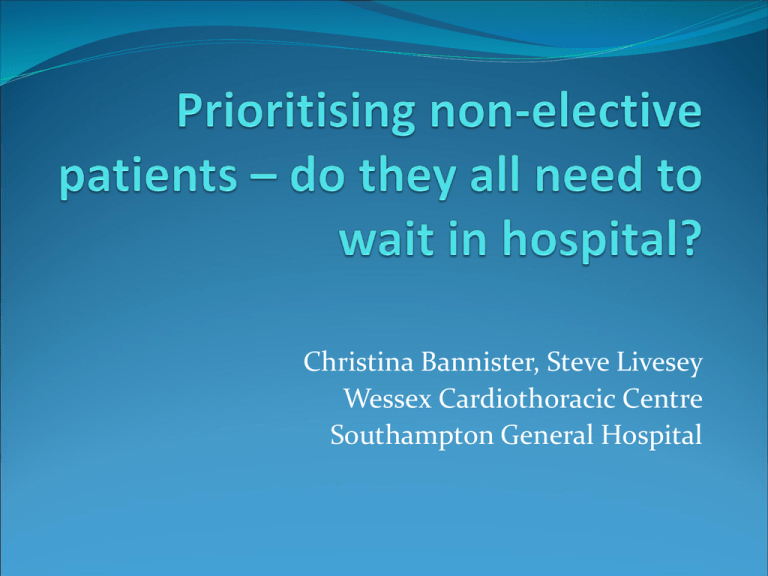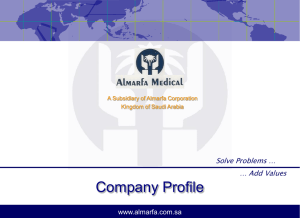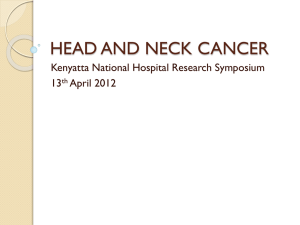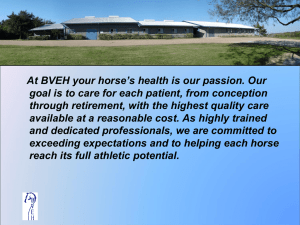Prioritising non-elective patients - Society for Cardiothoracic Surgery
advertisement

Christina Bannister, Steve Livesey Wessex Cardiothoracic Centre Southampton General Hospital Non-elective patient burden 1400 Elective 1200 NonElective 1000 NonElective 800 Preop Postop 600 400 Elective 200 0 2009 - 10 0 10 20 30 Rexius Scoring System To determine whether it was possible to reduce the length of stay for these non-elective patients, the Rexius Scoring System was implemented as a risk stratification tool for a period of four months. The model was created by Dr Helena Rexius et al in the Department of Cardiothoracic Surgery at Sahlgrenska University Hospital in Sweden. It was constructed to identify patients with increased risk of death while waiting for coronary artery bypass grafting. The score was used to facilitate and improve the prioritisation process. At Southampton General the Rexius Scoring System was used to identify the appropriateness of our practice, in prioritising all patients waiting for non-elective cardiac surgery. This was to ensure that the most urgent were operated on quickly, with low risk patients potentially being sent home to wait. Within the Rexius Scoring System, each patient receives a score for a set criteria: Rexius Scoring System ACS Troponin +ve 3 Troponin –ve 2 Angiogram LMS>50% 2 Valve Concomitant AV Disease 2 Gender Male 1 Operative Score EuroSCORE Reduced EF 0-3 0 4-6 1 >7 2 >50% 0 35-50% 1 <35% 2 Risk Groups All patients in our pilot period were assessed using this criteria and depending on which factors they showed a score was created. The total score then determined which risk group the patient was allocated to. The risk groups are: Risk of Waiting High Risk >6 points Medium Risk 3-5 points Low Risk 0-2 points Based on this risk stratification model, decisions were made regarding the timing of the patient’s operation. These are based on the guidelines created by Rexius and implemented by Healthcare for London. High Risk Patient to be transferred to a cardiac surgery unit and operated on as an in-patient within 1 week of admission Medium Risk Patient to be operated on within 2 weeks of admission Low Risk Patient to be sent home and date for operation must be within 4 weeks of admission The Role of the Nurse Case Manager At Southampton General Hospital there is a team of Nurse Case Managers (NCM) who manage individual Consultant caseloads. From outpatient appointments and pre-assessment clinics, through to admission for surgery and post-operatively on the cardiac wards. The NCM’s also manage the non-elective patient pathway, ensuring they are prepared for surgery, and are operated on in a timely fashion dependent on their disease process and symptoms. The Rexius Scoring System was therefore a potentially useful tool for the NCM’s to implement. This would ensure the non-elective patients who needed surgery the most were given priority over those who could have been sent home with a date for their operation. This had the possibility of freeing up beds, reducing patients’ length of stay in hospital and saving costs for the unit. Methods During a 4 month period 151 patients were referred to Southampton General Hospital for non-elective cardiac surgery. n=151 ACS Troponin +ve 74 patients LMS Stenosis >50% on Coronary Angiography 49 patients Aortic Valve Disease 65 patients Male 115 patients Median age 72 yrs (40-89) Mean additive EuroSCORE 5.52 EuroSCORE 4-6 58 patients EuroSCORE >7 54 patients LVEF 35-50% 41 patients LVEF <35% 10 patients Results The Rexius Scoring System was applied to each patient as they were referred. Patients High Risk 61 Medium Risk 85 Low Risk 5 Patients Accepted for cardiac surgery 140 Not suitable for surgery 9 Transfers revoked by DGH 4 Patient did not want operation 1 Patients died whilst waiting for surgery 4 Patients died post-operatively 5 Low Risk Patients The 5 low risk patients referred as non-elective patients were those that could have potentially been sent home with a date to come back for cardiac surgery. On closer clinical examination of these patients, it was identified that actually this was not to be possible. In all the cases, the patients had a disease process that fell outside the scope of the Rexius Scoring System therefore scoring them lower than was clinically needed. Of the 5 low risk patients: Patients Mitral Valve Disease 3 Pericardial Effusion 1 Left Atrial Myxoma 1 All these patients were clinically identified as needing urgent non- elective cardiac surgery and it was not possible to send any of them home to wait for their operations. Conclusions The Rexius Scoring System is a useful tool for prioritising non-elective patients. Referrals made were appropriate for all patients. The system is a guide, it cannot replace sound clinical judgement, and needs to be expanded clinically to include symptoms to be effective. The system was set up to assess patients waiting for Coronary Artery Bypass Graft Surgery only. The Rexius Scoring System only identified 5 low-risk patients None of the patients referred for non-elective surgery could be discharged home to wait for an early date This reflects the high risk profiles of this population of patients Discussion If non-elective patients referred to a tertiary centre for urgent cardiac surgery are sent home to wait, they are at potentially greater risk of an adverse event occurring. In today’s medical-legal society, is it better to keep all this group in hospital whilst waiting for surgery, thereby negating that risk, rather than trying to save costs?






